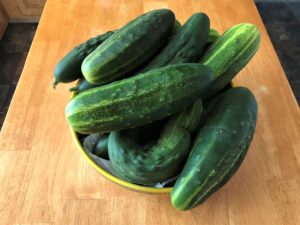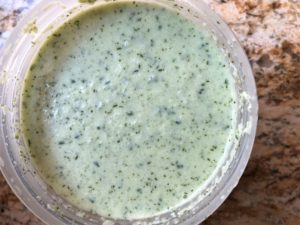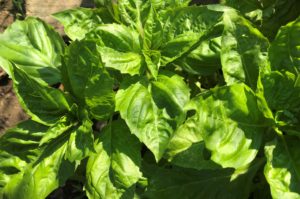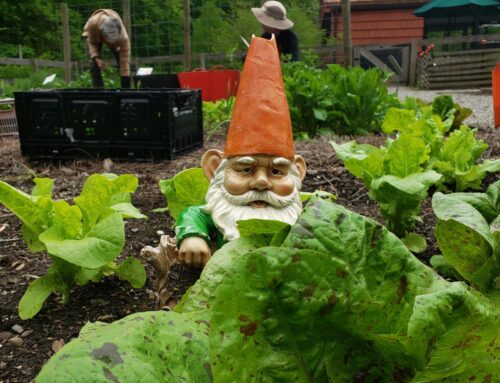It’s that time of year in the vegetable garden when you may have more harvest than you feel you can handle. Fear not! We have some ideas for you.
Some might be asking, “How did I get in this predicament?”
I won’t speak for you – I can speak only for myself – but I couldn’t pass up that set of six cucumber plants at such a great price. The outcome is better than you might think. I have successfully used all 86 cucumbers from my home garden to date. In addition, I really did not know how many cherry tomatoes would come from that one seed I started indoors in February. It did not transplant well in the spring, and I thought it was going to be a dud! Not true; I picked my 277th tomato this morning, and it is only the beginning of August. Don’t feel bad for me though. I am going to have some cherry tomatoes I roasted this afternoon with garlic, olive oil, and salt and pepper over my pasta for dinner tonight. Yum, yum!
Here are some ideas on what you can do with an abundant harvest of some of the most common vegetables and herbs in our home gardens:
Tomatoes – Is there a more iconic summer vegetable than a tomato? Few things taste better than a ripe cherry tomato still warm from the sun. But when the tomato crop comes in, it really comes in. So what should you do with your garden bounty?
Consider making homemade pasta sauce! This really couldn’t be easier. Just peel the tomatoes, squeeze out the excess water and seeds (save the seeds! Those can be stored and started indoors in February for next year’s garden) and throw them in a pot to simmer with garlic, basil and oregano. You can also add some fresh kale, peppers and/or zucchini for some extra nutrition, or white beans for protein. To lower the acidity a bit, sauté your garlic in a few tablespoons of butter. For a chunkier sauce, you can leave it as is, but if you are a fan of smooth pasta sauce, blend with an immersion blender. This sauce freezes beautifully and is a real treat on a cold winter night. Plus it’s a practical and thrifty alternative to store-bought jarred sauce.
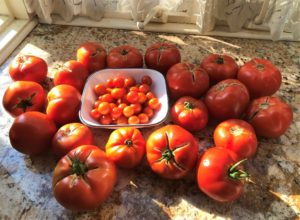
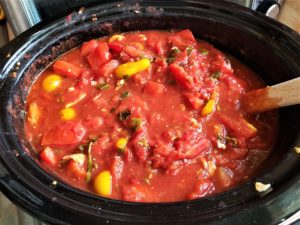
But that’s not all! You can also use those tomatoes for salsa, juice, jam, chutney, tomato paste, tarts, quiches, bread, frittatas, pizza sauce, tomato pies, vinaigrettes, marinades, stuffed tomatoes, skin cleanser, sunburn relief, soup, tomato sandwiches, fried green tomatoes, bruschetta, ketchup, salads, shakshuka or Bloody Marys. The list goes on!
To preserve the tomatoes, you can blanch and freeze them. You can also can them, but make sure to follow a recipe – the pH of tomatoes means that you need to add the right amount of an acid (lemon juice works well) to keep them from spoiling. With a little work, you’ll be all set to enjoy the taste of homegrown tomatoes well into the winter.
When all else fails: barter, give them away, sell them or leave bags on your neighbor’s porches. Warning! This does come with the risk that friends and family will see you coming with your harvesting basket and run the other way!
Cucumbers – A nice, cool cucumber is a refreshing treat on a summer day. But what should you do when your garden is laden with them?
The classic answer is, of course, make pickles! And it’s the go-to recipe for a reason. Simply cut up your cucumbers (in slices or spears – your choice!) and place them in a jar with equal parts water and vinegar. Add dill, garlic, a bay leaf, salt and pepper to taste and chill for an hour. That’s it! If you prefer a slightly sweeter pickle you can add the sweetener of your choice. These refrigerator pickles will keep for several weeks and are delightful with sandwiches and burgers. To store your pickles for even longer, process the cucumbers in a hot water bath for five minutes. This makes the pickles softer, but they are shelf stable for about a year – just in time for your next bumper crop.
If you want an alternative to pickles, you can use cucumbers to make a dip, a smoothie, gazpacho, cucumber salad (vinegar, sour cream or yogurt-based), tzatziki, cold cucumber soup, strawberry or watermelon cucumber salad, toss them in a drink (cucumber lemonade is especially delicious), add to stir fry, add to fresh salsa, or make a cucumber sandwich with cream cheese and dill. You can also use cucumbers as a homemade cooling face mask – just slice the cucumbers thin and place over irritated or oily skin.
Collard Greens – Collard greens are much like kale or swiss chard, with a slightly sweeter taste. And like kale and swiss chard, when you harvest them you get A LOT of collards. So how can you use them? The list is long – roast, blanch, pan-fry, sauté with bacon, roll up in a wrap, stir into soup, add to stir-fries, make chips, shred into a casseroles, puree into pasta, add to chili, or put in salads and slaws. The good thing about leafy greens is that they are so versatile; if you’re cooking dinner, odds are good you can toss a handful of collards in to pack your meal with nutrition.
To store collards for the winter, you can either follow traditional canning or blanch them for 15 seconds, package in air-tight bags and toss them in the freezer! Consider freezing them in small batches so you can pull a bag out each time you want to add them to soups, stews or sauces. Collards are high in protein and vitamin C, making them an excellent addition to your favorite winter dishes.
Japanese Mustard Greens/Mizuna – Mizuna is a dark, leafy green like collards, but with a peppery, slightly bitter taste. It makes a great addition to many of the same dishes and adds a ton of flavor. You can sauté mizuna, add it to potatoes with a lemon vinaigrette, include it in salads, scrambled eggs, stir-fries, and even as a gourmet pizza topping.
To store mizuna for winter, you can blanch and freeze them much the same way you do for collards. You can also pickle them! They are best as a ‘refrigerator pickle’ which just means that you place them in a jar and cover with equal parts water and vinegar, add a little salt and pepper and spice to taste. Consider adding a little hot pepper for an extra kick! Mizuna pickled this way will keep for about a week and makes a great, flavorful addition to your favorite stir fry.
Peppers –From sweet bell peppers to spicy hot varieties, there is a pepper out there for every taste – and just as many ways to serve them. Peppers make a great addition to soup or chili and can be roasted, smoked or pickled. They are a great pizza topping and can be added to a breakfast burrito if you want to start the day off with some veggies. You can roast and freeze them to add to winter dishes, puree them to mix with hummus, add finely diced sweet pepper to cornbread, brownies, muffins, and even make pepper jelly.
If you’re inundated with hot peppers you can also make homemade hot sauce! All you need to do is put your hot peppers (and some garlic and onion to taste) in the food processor with some salt and water and process until it’s pulpy. Then place in a glass jar, cover with cheesecloth and set it aside for a day. Then mix in vinegar and keep it covered with the cheesecloth as it ferments for a week. After that, blend it until it’s as smooth as you like it to be and store it in a glass container. Homemade hot sauce tastes fresh and delicious and makes an excellent gift for spice-loving friends and family.
Herbs: There are so many wonderful ways to use fresh garden herbs. Here are just a few…
Basil – Pesto, bruschetta, infused oil, use in soups and salads, pizza topping, add to fish and seafood dishes, use in sorbet
Dill – Add to butter, make vegetable dip, use in canned or refrigerator pickles, add to roasted potatoes, stir into potato salad, sprinkle on top of deviled eggs, toss into green salad, freeze, dry, use in dill pickle soup, dill-cilantro pesto
Chives – Add to sour cream and put on a baked potato, or fish, add to butter or cream cheese and spread on bagels, toast, or crackers, add the blooms to a salad, add to an omelet or scrambled eggs
Rosemary – Rosemary butter, pesto, rosemary salt, oil infusion and salve, simple sugar to drizzle over sponge, Bundt or angel food cake, jelly or jam for use on bread, chicken, fish or lamb, infused vinegar, rosemary lemonade, sachet, insect repellent, hair rinse, facial toner, bath salt
Thyme –Add to roasted meats, add to a salt and peppered slice of tomato, mix with melted butter and use on top of green beans, asparagus or carrots, mix with cream cheese and garlic and spread on a tortilla or wrap, add flowers to salad, add leaves to a vinaigrette
But what if you want to keep the flavor of your fresh herbs rolling – even after you’ve put your garden to bed for the year? There are many great ways to keep your herbs for the winter months. Most can be dried and stored in jars in your pantry, and you can also freeze them in airtight bags. Another great trick is to cut up fresh herbs and place them in an ice cube tray, cover with olive oil, and freeze. Then you can pop them out of the trays and store them in plastic bags to quickly add as you cook your favorite winter dishes. You can also add them to honey, vinegar or olive oil to make a flavorful dressing or sweetener. Or infuse them with the alcohol of your choice to bring a homegrown herbal touch to winter cocktails. Bonus…that makes for a great holiday gift, especially alongside some homemade hot sauce! The sky’s the limit for herbs, so let your creativity be your guide.
I hope these ideas have helped when it comes to managing the abundance found in your garden. We hope you will use your own creativity as well. Here’s to your health!


